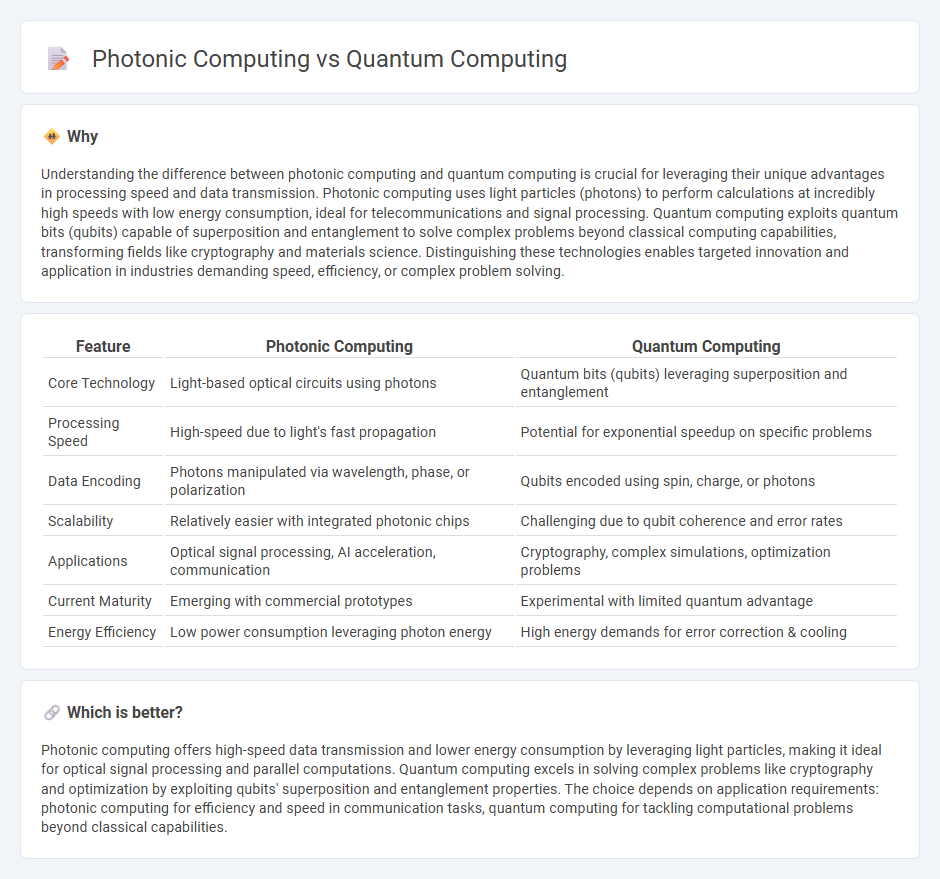
Photonic computing utilizes light particles to perform calculations at speeds unattainable by traditional electronic processors, leveraging the properties of photons for high bandwidth and low energy consumption. Quantum computing exploits quantum bits (qubits) and phenomena like superposition and entanglement to solve complex problems beyond classical computer capabilities. Explore the key differences and cutting-edge advancements in photonic and quantum computing technologies.
Why it is important
Understanding the difference between photonic computing and quantum computing is crucial for leveraging their unique advantages in processing speed and data transmission. Photonic computing uses light particles (photons) to perform calculations at incredibly high speeds with low energy consumption, ideal for telecommunications and signal processing. Quantum computing exploits quantum bits (qubits) capable of superposition and entanglement to solve complex problems beyond classical computing capabilities, transforming fields like cryptography and materials science. Distinguishing these technologies enables targeted innovation and application in industries demanding speed, efficiency, or complex problem solving.
Comparison Table
| Feature | Photonic Computing | Quantum Computing |
|---|---|---|
| Core Technology | Light-based optical circuits using photons | Quantum bits (qubits) leveraging superposition and entanglement |
| Processing Speed | High-speed due to light's fast propagation | Potential for exponential speedup on specific problems |
| Data Encoding | Photons manipulated via wavelength, phase, or polarization | Qubits encoded using spin, charge, or photons |
| Scalability | Relatively easier with integrated photonic chips | Challenging due to qubit coherence and error rates |
| Applications | Optical signal processing, AI acceleration, communication | Cryptography, complex simulations, optimization problems |
| Current Maturity | Emerging with commercial prototypes | Experimental with limited quantum advantage |
| Energy Efficiency | Low power consumption leveraging photon energy | High energy demands for error correction & cooling |
Which is better?
Photonic computing offers high-speed data transmission and lower energy consumption by leveraging light particles, making it ideal for optical signal processing and parallel computations. Quantum computing excels in solving complex problems like cryptography and optimization by exploiting qubits' superposition and entanglement properties. The choice depends on application requirements: photonic computing for efficiency and speed in communication tasks, quantum computing for tackling computational problems beyond classical capabilities.
Connection
Photonic computing and quantum computing are connected through their reliance on quantum mechanics principles to process information at unprecedented speeds and efficiencies. Photonic computing uses photons for data transmission and computation, enabling faster and lower-energy operations, which complements the quantum bits (qubits) manipulation in quantum computing systems. The integration of photonic components in quantum computing architectures enhances coherence times and scalability, driving advancements in complex problem-solving and encryption algorithms.
Key Terms
Qubit
Quantum computing relies on qubits, which can exist in superposition states, enabling parallel computation and exponential speedup over classical bits. Photonic computing uses photons as qubits, offering advantages such as low decoherence rates and high-speed information transfer, critical for scalable quantum systems. Explore the latest advancements in qubit technology to understand their impact on future computing paradigms.
Photon
Photon-based computing harnesses light particles to perform high-speed data transmission and processing, offering significant advantages over traditional quantum computing qubits due to reduced decoherence and increased stability. Photonic quantum computers utilize entangled photons to execute complex algorithms, enhancing computational power while operating at room temperature, unlike many quantum systems requiring cryogenic environments. Explore the cutting-edge developments in photonic computing to understand its transformative potential in future technology.
Superposition
Quantum computing exploits superposition by allowing qubits to exist simultaneously in multiple states, enabling massive parallelism for complex calculations beyond classical limits. Photonic computing harnesses superposition through the quantum states of photons, leveraging light's coherence and entanglement to perform computations with high speed and minimal thermal noise. Explore the nuances of superposition in these cutting-edge technologies to understand their potential impact on computing paradigms.
Source and External Links
Quantum Computing Explained | NIST - Quantum computers use quantum bits or qubits, which can exist in superpositions and entangled states, allowing them to process exponentially more information than classical bits, enabling powerful computations especially for complex problems.
DOE Explains...Quantum Computing - Department of Energy - Quantum computing leverages qubits whose quantum mechanical properties enable the encoding and manipulation of exponentially more information than classical bits, with promising applications in simulating quantum systems and optimization problems.
What is quantum computing? - McKinsey - Quantum computing exploits superposition and entanglement of qubits to explore many computational paths in parallel, offering a fundamentally different and more powerful approach compared to classical computing for solving complex problems.
 dowidth.com
dowidth.com